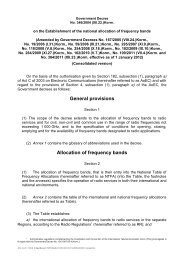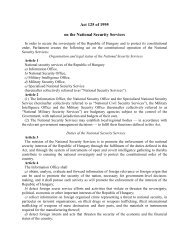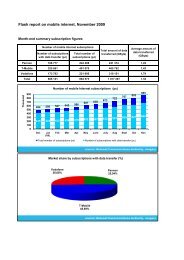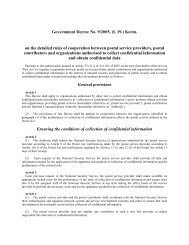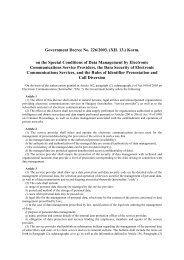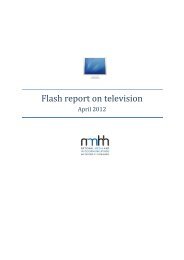The Hungarian Communications Market Developments and ...
The Hungarian Communications Market Developments and ...
The Hungarian Communications Market Developments and ...
You also want an ePaper? Increase the reach of your titles
YUMPU automatically turns print PDFs into web optimized ePapers that Google loves.
<strong>The</strong> <strong>Hungarian</strong> <strong>Communications</strong> <strong>Market</strong> <strong>Developments</strong> <strong>and</strong> Regulation between 2004 <strong>and</strong> 2008<br />
<strong>The</strong> Authority is responsible for the implementation of the EU <strong>and</strong><br />
international principles related to frequency usage <strong>and</strong> technical<br />
st<strong>and</strong>ards in Hungary’s national plans for frequency usage. To this<br />
end, the Authority is in charge of regularly reviewing the National Table<br />
for Frequency Allocations (FNFT) established by Government decree.<br />
Due to actual changes in the rules for b<strong>and</strong> usage <strong>and</strong> the modifications<br />
of FNFT by Government decree, the legal regulation required<br />
for the introduction of new technologies <strong>and</strong> changes in procedural<br />
<strong>and</strong> technical regulations decisive for b<strong>and</strong> usage, the updating of<br />
the ministerial decree on the rules for the use of frequency b<strong>and</strong>s 14 is<br />
carried out in line with the FNFT.<br />
Following 2004, the Authority contributed to the preparation of the<br />
modification of the decree on the Authority’s procedures of civil frequency<br />
management 15 , the decree on radio equipment <strong>and</strong> telecommunications<br />
terminal equipment <strong>and</strong> the mutual recognition of the<br />
conformity of such equipment 16 .<br />
<strong>The</strong> Authority continuously assesses the <strong>Hungarian</strong> implementation<br />
of EU recommendations <strong>and</strong> legal regulations as regards<br />
frequency management <strong>and</strong> continuously reports to ERO (European<br />
Radiocommunications Office).<br />
As part of its frequency management activities, the Authority<br />
continuously makes technical calculations in connection with telecommunications<br />
<strong>and</strong> broadcasting satellite networks <strong>and</strong> stations,<br />
carries out frequency planning, <strong>and</strong> the assessment of satellite<br />
networks <strong>and</strong> stations regularly published by ITU.<br />
International activities<br />
It is a key responsibility of frequency management to protect the<br />
country’s interests in international organisations <strong>and</strong> to represent the<br />
<strong>Hungarian</strong> administration in international organisations in charge of<br />
the regulation of radiocommunication.<br />
As part of this work, the Authority participates in the COCOM subcommittees<br />
in charge of increasing the effectiveness of frequency<br />
usage <strong>and</strong> harmonised European radio licensing procedures, <strong>and</strong> in<br />
the DICE project for speeding up the introduction of digital television<br />
broadcasting <strong>and</strong> incorporating previous experiences, as well<br />
as in the work of EU working committees (RSPG, RSC) dealing with<br />
frequency management policy.<br />
<strong>The</strong> Authority represents Hungary in the working groups of ITU<br />
organisations dealing with the fixed-location, l<strong>and</strong> mobile <strong>and</strong> radio<br />
applications as well as with the survey <strong>and</strong> regulation of the technical<br />
issues of spectrum management. Since 2004, the support the<br />
Authority provided to the working committees of the International<br />
Civil Aviation Organisation (ICAO), the Danube Committee <strong>and</strong> to<br />
the organisation ensuring frequencies for international inl<strong>and</strong> water<br />
transportation (RAINWAT Committee) as well as to the forums<br />
promoting the introduction of digital radio (World DAB) <strong>and</strong> television<br />
(EBU Forecast) has also been of great importance.<br />
<strong>The</strong> experts of NHH were also among the participants of the Regional<br />
Radiocommunication Conference (RRC-06), a major professional<br />
event of the year 2006, held in Geneva. <strong>The</strong> importance of the<br />
conference is signified by the fact that it has defined the conditions<br />
for television <strong>and</strong> radio free-to-air broadcasting for decades to come.<br />
<strong>The</strong> Geneva achievements mean a total number of eight television<br />
<strong>and</strong> three radio multiplexes for Hungary. After digital switchover has<br />
been completed, the capacity thus obtained will allow the national<br />
broadcasting of 30 to 40 television <strong>and</strong> some 20 radio programmes.<br />
In addition to increasing the number of programmes, the frequencies<br />
obtained will facilitate the introduction of new services such as interactive,<br />
high-definition (HDTV) <strong>and</strong> mobile (DVB-H) television services.<br />
Within the framework of the expert work carried out in CEPT<br />
organisations, the Authority has contributed to the definition of<br />
the technical conditions related to the introduction of new radio<br />
frequency technologies <strong>and</strong> applications, the establishment of a joint<br />
European frequency information system (WG FM EFIS) as well as to<br />
the efforts of the working groups in charge of preparing the WRC-07<br />
World Radiocommunication Conference <strong>and</strong> the formulation of a<br />
common European position. One of the topics of WRC-07 also decisive<br />
from a <strong>Hungarian</strong> point of view was the frequency b<strong>and</strong>s to be<br />
allocated to 3G <strong>and</strong> beyond-3G mobile systems. This will also have<br />
an impact on the rollout of broadb<strong>and</strong> mobile systems.<br />
Spectrum Strategy<br />
<strong>The</strong> number of services <strong>and</strong> applications using radiocommunication<br />
shows a steady rise, generating growing need for spectrum resources.<br />
<strong>The</strong>se facts together with the rapid change in the technologies used<br />
present intensive incentives for flexible <strong>and</strong> efficient spectrum management.<br />
A modern authority must have a medium term strategy that<br />
guarantees <strong>and</strong> serves the dynamic development of national radiocommunication<br />
in line with market <strong>and</strong> professional expectations. NHH<br />
developed its Spectrum Strategy for the period ending in 2010 in view<br />
of the Regulatory Strategy, identifying focus areas such as the development<br />
of public mobile communication, professional radiocommunication,<br />
short-range <strong>and</strong> long-range broadb<strong>and</strong> wireless data transmission<br />
(WMAN, WiMAX, Wi-Fi) <strong>and</strong> terrestrial digital broadcasting.<br />
<strong>The</strong> Authority has contributed to the development of the draft<br />
modification of Dtv. 17 , the National Audiovisual Media Strategy<br />
(NAMS), <strong>and</strong> the draft regulations concerning digital switchover.<br />
In connection with the NHH strategy <strong>and</strong> by investigating the<br />
regulatory conditions for flexible frequency use, the Authority has<br />
developed a model system for the simplified licensing of the 76 GHz<br />
broadb<strong>and</strong> data transmission system.<br />
A feasibility study concerning the regulatory conditions for secondary<br />
frequency trading has been presented, together with a codification-level<br />
recommendation for a law modification to facilitate frequency leasing.<br />
In order to facilitate quality broadb<strong>and</strong> data transmission, the<br />
Authority has prepared the use of 5.8 <strong>and</strong> 3.7 GHz b<strong>and</strong>s for the




